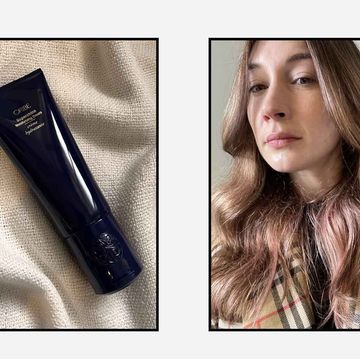Under normal circumstances, walking out of the hairdresser’s with a worse-looking head of hair than you walked in with would ring some alarm bells, especially if you’d just handed over £250 for the privilege. Worse still, leaving in tears is a sure sign to never return. And yet, I’d class my last Hari’s haircut as one of the best experiences of my life, and that’s said with no exaggeration.
While the depth of our emotional connection with our hair is rarely taken lightly – Coco Chanel’s famous phrase, 'A woman who cuts her hair is about to change her life,' and Anya Hindmarch’s book titled 'If In Doubt, Wash Your Hair' are just two well-known examples – Trichothérapy, less formally named an 'energy haircut', takes this relationship one step further.
Founded by Jill Andrieu, former L’Oréal professional and Wella ambassador, Trichothérapy brings a more holistic approach to a haircut. Focusing on releasing toxins, reviving shine and boosting vitality, the 90-minute three-step process positions the health of the hair as the main focus. Remarkably, no products are used. Instead, the cut involves a combination of water, a razor, and a small Japanese knife called a Tantõ that whips around the head, trimming just the smallest thimbleful of hair.
While Trichothérapy is primarily for hair health, 'It's more than just a treatment, it's a real meeting with yourself that goes beyond the hair,' proclaims Andrieu. After all, 'Hair is an essential source of information about us,' explains Sabrina Picot, senior stylist at HARI’s salon in London and one of 400 hairdressers trained in the practice. 'As it grows, it incorporates what is present in the blood and sweat and keeps a precise trace of what its owner has eaten, swallowed or smoked. In fact, if you take a 6cm strand of hair, it's your diary of the last six months that its owner has lived.' But, unlike the rest of your body that can sweat and excrete any unwanted toxins or materials, your hair has no way to shed these on its own.
The treatment begins with a head massage, although not in the style you’d expect from a standard shampoo and rinse - Trichothérapy touches on craniosacral system therapy (CST). The hands-on technique is said to help heal both physical and emotional trauma, stimulating the back of the head and the pineal gland (also referred to as the ‘third eye’) and preparing the body for the detoxification process. But before Picot can continue, my body has all but shut down, unable to move or utter a single word. Having ventured down somewhat unconventional health routes before, receiving Reiki, sound healing, breath work exercises, and even dabbling with tarot cards and mediums, my response was little cause for concern, although certainly unexpected.
Taking the Tantõ, swift upwards movements are made to cut the hair without crushing the strands as scissors would, sending 'a vibratory wave through the scales of the hair to the hair bulb in order to boost its vital energy', according to Picot. It’s then sealed in with the razor across the hair shaft. But, unlike a regular trim, you can physically feel each strand being cut from the root of your head. It's worth noting that, despite the sharpness of the tool, not all hairs shed easily, a key sign of emotional resistance, so I'm told.
For me, this resistance was held at the front right side of the head, which Picot explains relates to our first sexual experiences, something I’d much prefer to forget. Delving deeper, 'the right side is all related to your masculine energy, while the left side is related to the feminine energy. We keep all of the memories we don’t know we have stress from at the back of the head, while the front holds things that you are already aware of but haven’t let go of.' In theory Trichothérapy can trigger long-forgotten memories in some people, or revive the trauma of those hard-to-forget in others, prompting you to confront these emotions head-on, no matter how uncomfortable they may seem.
As a single tear rolled down my cheek, still unable to wipe it away, the connection between the hair, body and mind that Picot and Andrieu speak of came into sharp focus. Together we deduced that the entrapment inside my body reflected a feeling of being controlled in my current life, the front right resistance relayed to a past sexual experience I’d already tried to heal through traditional therapy, and a heavy cry expelled a strenuous six months' worth of emotions that every part of my body, hair included, felt incredibly weighed down by.
Unlike traditional methods of therapy, Trichothérapy is not a cure, rather an instrument to empower the road to self-healing. Through the combination of CST, the Tantõ’s detoxification of the hair and a ridding of the ‘negative energy’ scooped up from strands on the floor, my mind, hair and heart all felt a little lighter – not to mention my hair seemed stronger, bouncier and shinier than before.
















